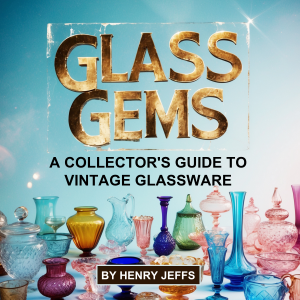

Glass Gems
Henry Jeffs
This audiobook is narrated by a digital voice.
Glass represents one of humanity's most remarkable material achievements, transforming simple sand into objects of breathtaking beauty and practical utility through the application of intense heat and skilled craftsmanship. The story of vintage glassware begins with understanding glass itself as both a scientific phenomenon and an artistic medium, where molecular structure and creative vision combine to produce treasures that have captivated collectors for generations.
The fundamental nature of glass as an amorphous solid gives it unique properties that distinguish it from crystalline materials. When silica sand is heated to temperatures exceeding 1700 degrees Fahrenheit, its molecular structure transforms into a fluid state that can be shaped, colored, and manipulated before cooling into its final form. This process requires precise control of temperature, timing, and technique, making glassmaking as much an art as a science.
Ancient civilizations discovered glassmaking techniques that established foundations still used in contemporary production. Egyptian glassmakers of 1500 BCE created the first decorative vessels using core-forming methods, while Roman artisans developed blowing techniques that revolutionized glass production efficiency and design possibilities. These early innovations established glass as both a luxury commodity and a medium for artistic expression, creating precedents that would influence glassmaking for millennia.
The addition of metal oxides to molten glass creates the spectacular color variations that make vintage glassware so visually compelling. Cobalt produces deep blues, chromium creates emerald greens, gold generates ruby reds, and silver can produce everything from amber to pale yellow depending on the firing conditions. Understanding these chemical relationships helps collectors appreciate the technical mastery required to achieve consistent colors and recognize the significance of rare or unusual hues.
Duration - 42m.
Author - Henry Jeffs.
Narrator - Digital Voice Mason G.
Published Date - Tuesday, 21 January 2025.
Copyright - © 2025 Henry Jeffs ©.
Location:
United States
Description:
This audiobook is narrated by a digital voice. Glass represents one of humanity's most remarkable material achievements, transforming simple sand into objects of breathtaking beauty and practical utility through the application of intense heat and skilled craftsmanship. The story of vintage glassware begins with understanding glass itself as both a scientific phenomenon and an artistic medium, where molecular structure and creative vision combine to produce treasures that have captivated collectors for generations. The fundamental nature of glass as an amorphous solid gives it unique properties that distinguish it from crystalline materials. When silica sand is heated to temperatures exceeding 1700 degrees Fahrenheit, its molecular structure transforms into a fluid state that can be shaped, colored, and manipulated before cooling into its final form. This process requires precise control of temperature, timing, and technique, making glassmaking as much an art as a science. Ancient civilizations discovered glassmaking techniques that established foundations still used in contemporary production. Egyptian glassmakers of 1500 BCE created the first decorative vessels using core-forming methods, while Roman artisans developed blowing techniques that revolutionized glass production efficiency and design possibilities. These early innovations established glass as both a luxury commodity and a medium for artistic expression, creating precedents that would influence glassmaking for millennia. The addition of metal oxides to molten glass creates the spectacular color variations that make vintage glassware so visually compelling. Cobalt produces deep blues, chromium creates emerald greens, gold generates ruby reds, and silver can produce everything from amber to pale yellow depending on the firing conditions. Understanding these chemical relationships helps collectors appreciate the technical mastery required to achieve consistent colors and recognize the significance of rare or unusual hues. Duration - 42m. Author - Henry Jeffs. Narrator - Digital Voice Mason G. Published Date - Tuesday, 21 January 2025. Copyright - © 2025 Henry Jeffs ©.
Language:
English
Start
Duration:00:42:54